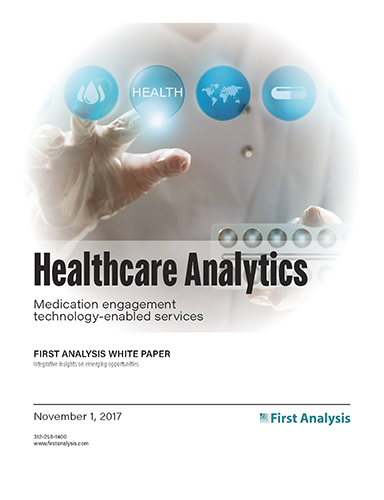White paper: Healthcare analytics
Medication engagement technology-enabled services: Improving patient outcomes and safety and lowering healthcare costs

During September 2017, the U.S. Senate Committee on Health, Education Labor & Pensions (HELP) held hearings on stabilizing the individual health insurance markets. During the hearings, a broader theme emerged: Lawmakers should be focused on the larger and fundamental problems of the healthcare delivery system that are driving unsustainable cost increases, specifically 1) high and increasing prescription drug costs, 2) payment reform to align incentives between payers and providers, and 3) price transparency. All of these are the focus of this report.
According to the Centers for Disease Control and Prevention, in any given month, 48% of Americans take a prescription medication and 11% take five or more prescription medications. This latter group, typically the elderly and chronically ill, is at significant risk of an adverse drug event (ADE) and account for a disproportionate share of overall healthcare spending. A study by the U.S. Department of Health and Human Services (HHS) notes ADEs cause approximately 125,000 hospitalizations, one million emergency room visits, two million affected hospital stays, and 3.5 million physician office visits every year.
In this report, we discuss the medication technology-enabled services market, including transparency, adherence, and management (e.g., prior authorization and safety), and review some of the most important industry players.
TABLE OF CONTENTS
Includes profiles of 38 public and private companies
- Industry drivers
- Overview
- Adverse drug events
- Medication therapy management
- Medication safety
- Prescription spending
- PACE
- Value-based care
- Medication adherence
- Substance abuse
- 340B
- Industry players
- Company profiles
Industry drivers: overview
Whether it’s the opioid epidemic, President Trump attacking high drug prices, or Amazon’s rumored entry into the prescription drug market, drugs are an important topic in the healthcare debate. The U.S. spends substantially more per capita on prescription drugs than any other country at $1,112 in 2015. According to a May 2017 QuintilesIMS report, U.S. spending on prescription medicines in 2016 increased 5.8% in 2016 (less than half the rate in the prior two years) to $450 billion based on list prices and 4.8% to $323 billion adjusted for discounts and rebates.
The basic pharmacy reimbursement model starts with the payer, Medicaid, Medicare, or private pay (commercial), which base their rates on a formula such as average wholesale price (AWP). There are two components:
1) A dispensing fee to compensate the pharmacy for transferring the drug from the pharmacy to the patient including overhead (stocking and storing medications) and patient counseling. According to a joint study commissioned by the National Community Pharmacists Association and the National Association of Chain Drug Stores reviewing 1.2 billion prescriptions, the national average cost of dispensing medications is $10.55 per prescription with different amounts paid per payer.
2) The prescription drug cost component, with most third-party payers basing reimbursement on a fixed discount from the AWP (e.g., AWP minus 10%), which is reported in publications such as Medispan and First Databank.
The pharmaceutical industry is a significant component within the broader healthcare industry (total spend of $3.4 trillion), particularly given its impact on cost ($400 billion of annual spend per Express Scripts) and outcomes, including patient safety. In June 2017, the Committee on Health, Education, Labor and Pensions (HELP) in Congress hosted a hearing on “The Cost of Prescription Drugs: How the Delivery System Affects What Patients Pay.” There were a number of common themes including the use of value-based or outcome-based contracts (OBCs) as a critical tool in slowing drug costs. High drug prices are limiting access to drugs for millions of Americans with multiple chronic conditions (there are an estimated 5 million Medicare beneficiaries with five or more chronic conditions).
According to the Kaiser Family Foundation (KFF), for Medicare beneficiaries with Part D coverage, out-of-pocket costs averaged $7,000 for drugs to treat hepatitis C, $4,000 for drugs to treat rheumatoid arthritis, and $8,000 for drugs to treat certain types of cancer. Cost impacts medication adherence and, ultimately, outcomes with a December 2016 KFF poll showing one in five Americans did not fill prescriptions because of cost and one in six Americans cut pills in half or skipped doses in the prior year.
The momentum around OBCs is building with industry partnerships forming. Examples include 1) UPMC establishing a new group, the Center for Value-Based Purchasing, to change the way medications are paid for, supported by UPMC Health Plan (3.2 million members) and Express Scripts, and 2) Optum (the health services division of UnitedHealth Group) and Merck announcing a partnership to develop and simulate the performance of contractual reimbursement models whereby payment for prescription drugs is aligned with patient health outcomes. Optum noted the initiative will involve the use of real-world data to co-develop and test advanced predictive models and co-design outcomes-based risk sharing agreements to reduce clinical and financial uncertainty with respect to payment for prescription drugs.

Request full report
To access the full report, please provide your contact information in the form below. Thank you for your interest in First Analysis research.
